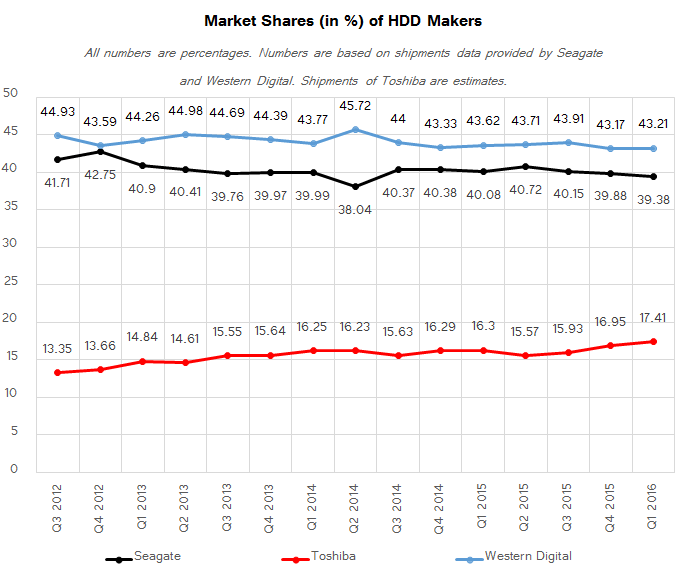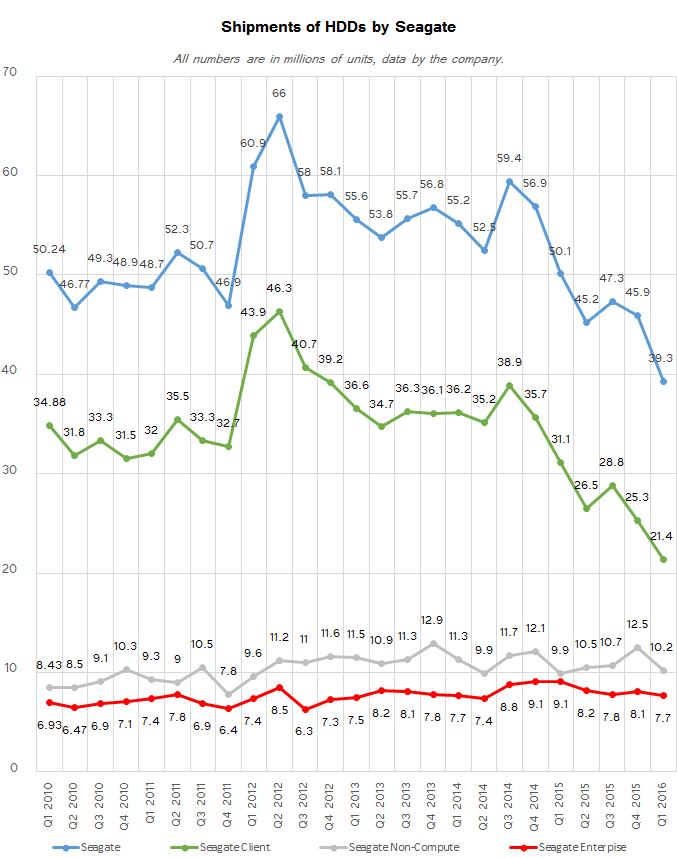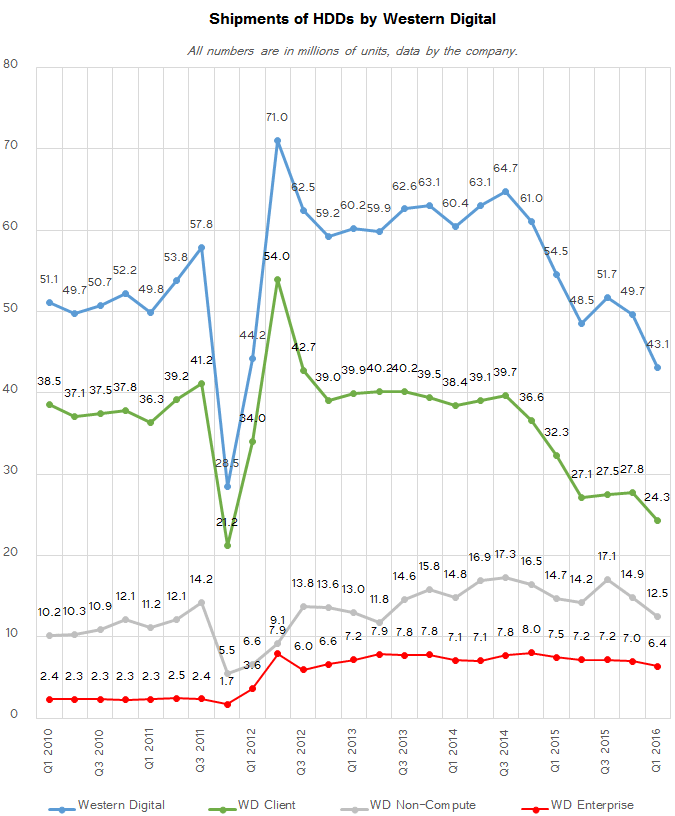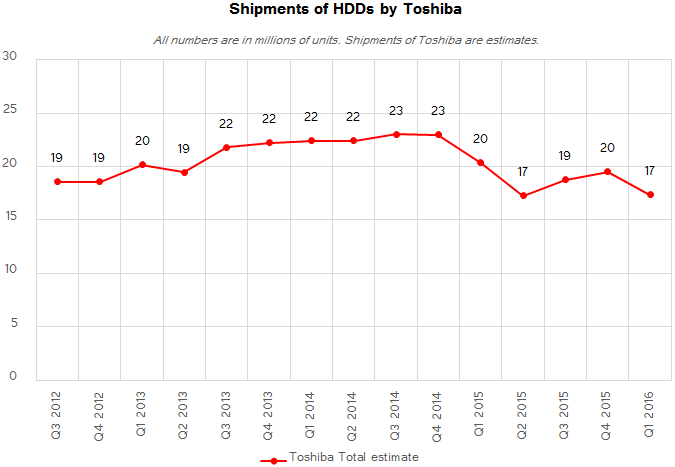Market Views: HDD Shipments Down 20% in Q1 2016, Hit Multi-Year Low
by Anton Shilov on May 12, 2016 8:00 AM ESTWestern Digital Remains World’s No. 1 HDD Supplier
Due to severe declines in demand for hard drives, it does not look like HDD makers want to fight for market share. Western Digital controlled about 43% of the HDD market in Q1 2016, just like a quarter before. Seagate was the second largest supplier with 39.38% market share. If the HDD shipments numbers for Toshiba are correct, then the company controlled around 17% of the hard drive market, moving ever so slightly higher.
Seagate’s HDD Sales Drop Below 40 Million Units, Company Plans Capacity Adjustments, Product Cuts
Seagate sold 39.3 million hard drives in the first quarter of 2016, a 21.5% decline from the same period a year ago. Sales of Seagate’s HDDs dropped across the board - with the exception of nearline drives. During the conference call with investors and financial analysts, the company particularly noted weak sales of client HDDs as well as declines in shipments of traditional mission-critical drives. Moreover, in a bid to maintain margins, the firm decided to “not aggressively participate in certain areas of the low capacity notebook market,” which further drove its unit sales down.
As it appears, Seagate does not seem to be confident that the hard drive market will rebound in the foreseeable future. The HDD maker intends to cut-down its manufacturing capacities from 55 – 60 million units per quarter to approximately 35 – 40 million units per quarter, which will help it to reduce operating costs and maintain prices despite competition from traditional and emerging rivals.
“In the March quarter we began the process of reducing our HDD manufacturing capacity from approximately 55 million to 60 million drives per quarter to approximately 35 million to 40 million drives per quarter,” said Steve Luczo, chief executive officer of Seagate, in a conference call with investors and financial analysts. “The actions required will be completed within the next 6 to 9 months. At the same time, we will continue to accelerate the utilization of our own drive factories internally and media facilities.”
While Seagate does not detail its capacity-cutting plans, it indicates that it intends to shift build volumes to its higher capacity models, which will simplify wafer requirements, optimize the lineup and will eventually reduce costs. In particular, the company will discontinue some of its low-capacity client HDDs (250 GB, 320 GB and 500 GB), which will help to increase its ASPs (average selling prices) and margins.
“In [Q1 2016] we began end-of-life activity on some of the older 500 GB and below products that have very low margins,” said Dave Mosley, president of operations and technology at Seagate. “Most of the margin cost benefits of these products will be realized over the next few quarters.”
In fact, Seagate began targeted pricing increases across its product portfolio already in the third quarter of its fiscal year (i.e., Q1 2016), which could help to improve its financial results. The manufacturer believes that higher HDD prices are justified because HDDs are getting harder to make. Since the company decided not to participate in some areas of the low capacity laptop market, it is evident that it may leave it to makers of entry-level SSDs in the future.
“In the March quarter we initiated targeted pricing increases across our product line, we were successful in some areas and unsuccessful in other,” said Mr. Luczo. “We continue to believe the industry needs a stable pricing environment to deliver the higher level of requirements being placed on our products and to realize the value we are providing to the market. As a result, we will continue to pursue a pricing strategy that reduces and properly reflects the investment in technology the market requires.”
Shipments of Western Digital’s HDDs Fall to 43.1 Million Units
Western Digital shipped 43.123 million of HDDs in the first three months of this year, or 21% less compared to Q1 2015. Sales of the company dropped across the board due to the weak PC market and seasonality. Just like Seagate, Western Digital increased prices of certain products during the quarter. In particular, the company hiked prices of some of its 2.5” drives for notebooks and gaming PCs (which is probably the WD Black2 Dual Drive). Right now, the company is making selective price increases in the enterprise segment in a bid to maintain its ASPs and margins and sustain its ability to invest in the development of products.
“Because we want to make sure that we have got sufficient dollars to reinvest back into our business to continue to innovate and provide compelling products for our customers, we are making selective price increases in certain enterprise markets,” said Stephen Milligan, chief executive officer of Western Digital, in a conference call with investors and financial analysts. “At this point, we are not sure if they're going to stick, but we are certainly hoping that they do.”
Earlier this year Western Digital announced plans to optimize its roadmap and close-down its head wafer manufacturing facility in Otawara, Japan, in a bid to reduce costs and maintain its profitability. So far, the company has not announced plans to reduce its HDD manufacturing capacities significantly but said it would eliminate redundant facilities. The company also did not make any comments regarding the future of its low-end HDDs.
Toshiba’s HDD Shipments Drop Too
Since Toshiba does not disclose anything related to its hard drive business, it is hard to analyze this supplier. If estimations of HDD makers and Nidec are correct, then Toshiba’s HDD shipments in Q1 2016 should be around 17 million units, or 15% below its shipments in the same period last year.














116 Comments
View All Comments
yannigr2 - Thursday, May 12, 2016 - link
I have enough space to not buy a hard disk drive the next 2-3 years. I think I bought my last HDD 2 years ago. Probably this is the case with most people and with SSDs taking the place of boot drives, HDD companies are losing the low capacity market.For most people who build new systems, they wouldn't know what to do with all that space a 240GB SSD will offer them. No second HDD for them, not to mention that a 128GB USB flash drive sometimes will do the trick, if they need to clean up some space from their SSD, without having to call the technician to install the HDD. On the other hand, people who need space will go for one 4TB or bigger drive, probably external, instead of buying more HDDs with lower capacities to put into their PC case.
Old PCs have enough capacity, new PCs go for an SSD or just a single high capacity HDD, instead of many with lower capacity.
Gigantopithecus - Thursday, May 12, 2016 - link
This. Last year I built about 30 desktop computers for typical home users (i.e., office/light productivity, HTPC, and gaming rigs) - three had a spinning hard drive in them. The average user is usually fine with a 250ish GB SSD, and if they run short on room, I tell them to buy a pair of 64GB USB flash drives for $20-30 total.Anton mentions the rise of 4K video as potentially spurring more sales of higher capacity hard drives, but I rarely have anyone ask about how to store even BR-D-quality video, so I'm skeptical that 4K will become a serious driver of increased household storage needs this decade. (At least at the consumer level.)
bill.rookard - Thursday, May 12, 2016 - link
The thing is, even if some small percentage do wind up needing more storage (unlikely), many routers these days do actually offer a USB port for attaching and providing access to a HDD. That means even if they have multiple computers or devices, they don't need more than one large capacity HDD for a single household. Heck, you can get a 4TB Seagate external 2.5" hdd (actually twin 2TB's with a USB -> SATA RAID) for $150 at the local Walmart.The net result in the massive increase in HDD storage capacity along with the rise of the medium capacity (250-500GB) SSD means that your average household has gone from multiple HDDs in their laptops/computers to a single central HDD.
Of course, there are exceptions (I have about 30TB of storage here, but I'm an extreme edge case...) so this will continue to be the trend. Your average storage capacity needs for an entire household are increasing far slower than the average increase in HDD capacity vs price.
JeffFlanagan - Thursday, May 12, 2016 - link
Is 30TB really an extreme edge case? Anyone with a serious video collection will surpass that pretty quickly, and if they're using a DrivePool, they'll use at least 60TB in drive space to store that 30TB.OVerLoRDI - Thursday, May 12, 2016 - link
Or Plex peopleLolimaster - Friday, May 13, 2016 - link
Just a collection of movies, anime (h264/HEVC quality) comics andmanga and you're looking at 30TB's for storage in a matter of a few years.Michael Bay - Monday, May 16, 2016 - link
>using hevc before our Lord and Savior Daiz ordered us toBlasphemer.
Gigaplex - Friday, May 13, 2016 - link
I have a storage array of 9TB usable capacity. Of all the people I know personally, only my brother has a larger storage array. While it's quite easy to get larger than that now, it's definitely not common. So yes, I'd definitely consider 30TB to be an extreme edge case in the grand scheme of things.azazel1024 - Friday, May 13, 2016 - link
Yeah, I have to agree with you Gigaplex. I consider my library to be pretty generous. I probably have something like ~500 movies and maybe 30-40 TV series (granted most are just 1-2 seasons, but some are 5-8), plus some music and pictures (and not JPEGs, but a LOT of RAW images since I am a photographer, even if not a professional). Currently on my 6TB array (5.4TiB formatted) I have 2.86TiB free. I still have some older SD content (or there IS no HD version) where I only have the DVD that I ripped and a lot of my BR collection I only ripped at 720p, but right now I am at about 10% 1080p, 50% 720p and 40% 480p content.I wouldn't consider that a small collection, but I don't need anything like 30 terabytes of storage. Maybe if my entire collection was BDMVs instead of transcoded down files. There gets to be a point though where that is kind of ridiculous to do and is absolutely not "common". Hell, I probably represent 1% of computer users as it is, the ones who have all of their DVDs and BRs in unreduced files are probably 1% of the 1%.
At my rate of growth, I've figured I have about 3-4 more years before I need to worry about storage at all (I don't like having less than ~20% free capacity, or about 1TiB free in this case) and maybe somewhat longer as I do occasionally cull my collection when I realize I haven't watched a movie or something since I bought it years ago, so it gets wiped and I either donate the BR/DVD or I'll just stuff it in a box and forget about it. My collection growth is still positive though, but we are talking maybe 20-40GiB a month (buy a few BRs a month, pictures I've taken, etc.), maybe .5TiB a year.
I doubt it'll happen, but some of me hopes that TLC/3D NAND SSDs are cheap enough by the time I am hitting my self imposed limits just to replace spinning disks in my desktop and server (data is mirrored between them and on 2x3TB RAID0 arrays, plus an external 5TB USB3 disk as a 3rd copy). Probably still too expensive, but I can hope the prices are lower enough and I have the budget to pony up $500-700 to replace the disks in both machines with SSDs (hoping and figuring maybe in 4 years the price of cheap SSDs has dropped under 5 cents per GB). Even if SSD storage is <20%, the beauty there is they are so much faster, no worries about arrays and I can just create a storage pool and add SSDs to it as capacity starts hitting <10% free.
I only have 2Gbps throughput on my network right now (SMB Multichannel, dual 1GbE links). Though I am also hoping in 4 years 2.5GbE or 5GbE networking gear will be on the market...so even SSDs might be a bottleneck on my network some day (but I think I can probably live with that. I'd love multi GB/sec throughputs on my network, but I am barely realistic enough to know I don't actually need it at all, 200+MB/sec is plenty and not worth the cost to try to realize more than 300 or 400MB/sec in the next few years).
Wolfpup - Thursday, July 14, 2016 - link
Oh yeah, RAW images...I wasn't even thinking about that. If you're any kind of remotely serious photographer you'd need gigantic piles of storage too.I remember like early 2000s I had like an 80GB drive in my main system, which was fine. Storage requirements have just absolutely ballooned since then though, while it seems like the rate of drive size increases has massively slowed.